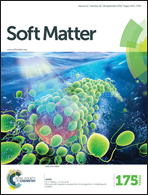The impact of viscoplastic drops on a heated surface in the Leidenfrost regime
Abstract
The impact morphology of viscoplastic drops on a heated surface in the Leidenfrost regime is investigated experimentally by high-speed imaging. In particular several important parameters which characterize the impact morphology (such as maximum spreading diameter, minimum retracting diameter and maximum bouncing height etc.) are measured by analysing the impact process, recorded using a high-speed camera. It is shown that as the yield stress grows, surface forces are no longer able to minimize the free surface of the drop, and the inertial deformation upon impact becomes permanent. For small values of the yield stress, the impact morphology of viscoplastic Leidenfrost drops is similar to that of Newtonian drops. These effects can be interpreted in terms of the Bingham–Capillary number, which compares the yield stress magnitude and the capillary (Laplace) pressure. These results suggest that the main contribution to drop rebound is due to surface forces, and not to the intrinsic elasticity of the vapour cushion between the drop and the surface, which is a major assumption in one of the existing models.


 Please wait while we load your content...
Please wait while we load your content...